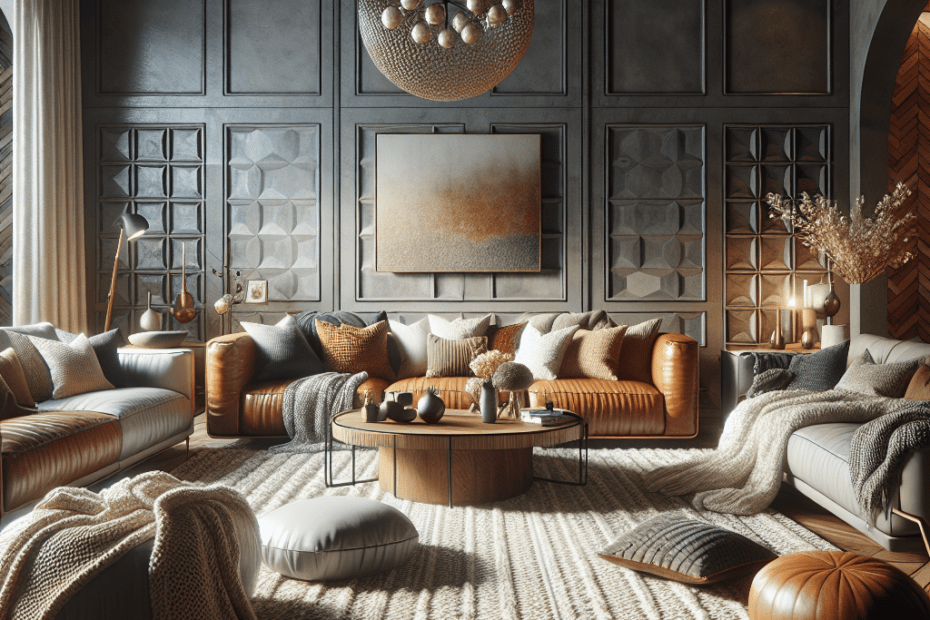The Power of Texture in Living Room Design
When it comes to decorating living spaces, many people often underestimate the significance of texture in living rooms. However, textures play a vital role in creating an inviting, warm, and aesthetically pleasing environment. Incorporating various textures can elevate the look and feel of a living area, transforming it into a cozy retreat or a stylish sanctuary.
The concept of texture extends beyond just fabrics. It encompasses a range of elements including the surfaces of furniture, wall treatments, and decorative accessories. Each texture has the potential to impact the room’s atmosphere by adding depth, visual interest, and balance.
Understanding the Impact of Texture
Texture can significantly affect the emotional response and functionality of a living space. For instance, rough textures tend to make a room feel warm and cozy, while smooth textures can impart a sleek and modern vibe. According to the American Society of Interior Designers, 78% of professional interior designers agree that texture enhances the overall design of a room (ASID).
By mixing and matching different textures, individuals can create a tactile experience that resonates with personal preferences and the intended purpose of the space. Whether it’s the plush feel of a velvet sofa or the ruggedness of a reclaimed wood coffee table, texture is a powerful tool for achieving the desired emotional response.
Key Elements of Texture in Living Rooms
To implement texture effectively, one must consider several elements:
| Element | Description |
|---|---|
| Fabrics | Incorporate materials like velvet, linen, cotton, or wool to add variety. |
| Wall Treatments | Think wallpaper, paint techniques, or textured panels to create contrast. |
| Flooring | Use rugs or carpets with a tactile feel to anchor the space. |
| Decorative Pieces | Incorporate metal, ceramic, or glass items for added dimension. |
Practical Tips for Incorporating Texture
Integrating texture into a living room design does not require an overhaul. Here are some practical tips:
- Layer Textures: Combine different textures for a layered look. Pair a smooth leather couch with a knitted throw to create balance.
- Consider Contrast: Use contrasting textures to make areas of interest pop. A wooden bookshelf against a smooth wall adds depth.
- Focus on Accessories: Textured cushions, rugs, or curtains can add dimension without overshadowing the main elements.
- Play with Light: Different materials reflect light in varying ways, so consider how natural and artificial light will interact with textures.
Benefits of Textured Designs
The proper use of texture can bring several benefits to living room design:
- Enhanced Aesthetic Appeal: Texture enriches the visual composition, making a space more dynamic.
- Improved Comfort: Textures can contribute to warmth and comfort, essential for relaxation areas.
- Personalization: A mix of textures can be tailored to reflect individual styles and tastes.
Research from interior design analyses indicates that homes with well-balanced textures have a 33% higher probability of a positive emotional impact on occupants (Interior Design).
Key Takeaways
- Texture is crucial for creating an inviting and visually appealing living room.
- Mixing different textures adds depth and balance to the space.
- Fabrics, wall treatments, flooring, and decorative pieces are key texture elements.
- Layering, contrast, and accessorizing are effective methods for incorporating texture.
- Textured designs enhance aesthetic appeal, comfort, and personalization.
FAQ
-
What are some easy ways to add texture to a living room?
Use textured wallpapers, add throw pillows with different fabrics, or incorporate a textured area rug to quickly add texture.
-
Can texture affect the perception of a room’s size?
Yes, textures can influence how spacious or cozy a room feels. Smooth textures often make a space feel larger, while rough textures can make it feel more intimate.
-
Is it possible to overdo texture in a room?
While texture can add interest, too much can overwhelm a space. It’s important to balance textures and avoid too many competing elements.
-
How can texture be used in minimalist designs?
In minimalist designs, subtle textures like matte finishes or soft linens can add sophistication without cluttering the space.
-
What are the best textures to combine for a cozy living room?
Warm woods, soft fabrics like wool or chenille, and plush rugs contribute to a cozy atmosphere.
